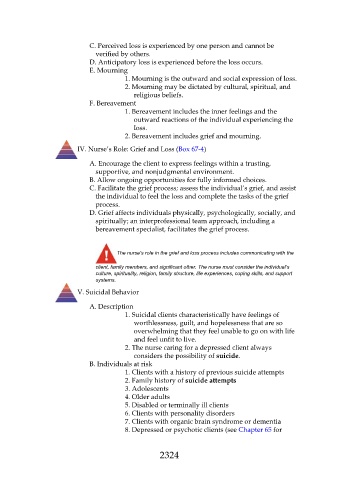Page 2324 - Saunders Comprehensive Review For NCLEX-RN
P. 2324
C. Perceived loss is experienced by one person and cannot be
verified by others.
D. Anticipatory loss is experienced before the loss occurs.
E. Mourning
1. Mourning is the outward and social expression of loss.
2. Mourning may be dictated by cultural, spiritual, and
religious beliefs.
F. Bereavement
1. Bereavement includes the inner feelings and the
outward reactions of the individual experiencing the
loss.
2. Bereavement includes grief and mourning.
IV. Nurse’s Role: Grief and Loss (Box 67-4)
A. Encourage the client to express feelings within a trusting,
supportive, and nonjudgmental environment.
B. Allow ongoing opportunities for fully informed choices.
C. Facilitate the grief process; assess the individual’s grief, and assist
the individual to feel the loss and complete the tasks of the grief
process.
D. Grief affects individuals physically, psychologically, socially, and
spiritually; an interprofessional team approach, including a
bereavement specialist, facilitates the grief process.
The nurse’s role in the grief and loss process includes communicating with the
client, family members, and significant other. The nurse must consider the individual’s
culture, spirituality, religion, family structure, life experiences, coping skills, and support
systems.
V. Suicidal Behavior
A. Description
1. Suicidal clients characteristically have feelings of
worthlessness, guilt, and hopelessness that are so
overwhelming that they feel unable to go on with life
and feel unfit to live.
2. The nurse caring for a depressed client always
considers the possibility of suicide.
B. Individuals at risk
1. Clients with a history of previous suicide attempts
2. Family history of suicide attempts
3. Adolescents
4. Older adults
5. Disabled or terminally ill clients
6. Clients with personality disorders
7. Clients with organic brain syndrome or dementia
8. Depressed or psychotic clients (see Chapter 65 for
2324

